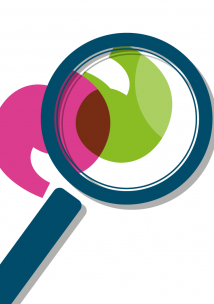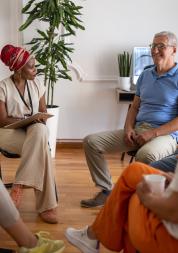Our equality, diversity and inclusion roadmap
As the COVID-19 pandemic has starkly highlighted, health outcomes and access to support are not equal. With data suggesting that if you live in a deprived area, you are twice as likely to die from COVID-19, the pandemic has shone a light on long-standing health inequalities. This has strengthened the conviction that society must address the worse health outcomes some people face just because of where they live, their income and their race.
With the NHS and social care services facing a significant backlog of care, health inequalities will worsen unless we collectively act.
Doing nothing is not an option. The public and the communities we serve demand change and will hold organisations to account for delivery.
What do those in power need to do?
Tackling unfair health differences will need those in power:
- To listen,
- To hear the experiences of those facing inequality and understand the steps that could improve people’s lives,
- And then to act on what has been learned.
At Healthwatch, we stand ready to help tackle health inequalities.
What do we need to do?
Our national strategy includes an explicit commitment to amplifying the voices of communities whose views go unheard, overlooked, or ignored and reducing the barriers they face.
We have also developed this three-year roadmap to support our strategy and put equalities at the heart of our work.
The task we have set ourselves will not be easy and will require us to ask ourselves hard questions.
Our roadmap
Our task in brief
- Think about equalities, diversity and inclusion in every aspect of our work.
- Continually ask what more we can do to listen to those the system overlooks and address any barriers to participation,
- Make sure our evidence is heard and acted upon.
The journey so far
In our 2019-20 equalities plan, we committed to taking stock of our current approach, mapping what we were already doing and regularly report progress.
With the help of secondee Joy Beishon, Chief Executive of Healthwatch Greenwich, and the views of over two-thirds of local Healthwatch, we have now been able to update our plan and start to put in place the building blocks to ensure we meet the diverse needs of the communities we serve.
Together, we have also developed new Healthwatch values, which have equalities, diversity and inclusion at their core.
The opportunities we can build on
Our conversations with local Healthwatch highlighted the overall commitment of our Boards, staff and volunteers to put equalities at the heart of our work.
Our review also found how we can learn from local Healthwatch teams leading the way when it comes to embedding equality in their work.
We have also started taking practical steps, which we need to see through:
- Delivering new resources to help you engage different sections of the community
- Developing key systems, like how our data is categorised, to help us better understand who we are engaging
- Reviewing our accessibility policy and making sure that our public websites and communications are accessible
- Delivering training on the public equality duty and how it applies to Healthwatch
Our work in action
At a national level
The fruits of this focus are already being seen. As the national COVID-19 vaccination campaign got underway, we published the ‘VacciNation’ report. The research explored vaccine confidence amongst people from African, Bangladeshi, Caribbean, and Pakistani backgrounds to help the NHS understand more about people’s views of the campaign.
Using in-depth interviews and on-line exercises, the research found that while attitudes to the COVID-19 vaccine are incredibly personal, we must understand the reasons behind mistrust and low confidence in our healthcare system to help address health inequalities moving forward.
The research also uncovered several ways to increase public confidence in future public health campaigns.
These included:
- The importance of individual agency: give people the ability to decide about the vaccine by providing them with all the information.
- Using those who are seen as independent: people are more likely to trust organisations and people, like doctors, scientists and the NHS, when they act independently from the government.
- Promoting transparency: transparency and trust go hand in hand. It’s essential to make all information about the vaccine public and accessible.
- Not making people feel targeted: Black and Asian people felt singled out and forced into a decision through targeted campaigns. Reaching out to these communities and engaging locally and directly was more effective.
At a local level
Supporting Black Caribbean men to raise health concerns
Healthwatch Lancashire worked with the Windrush Health Group to tackle issues facing Black Caribbean men. These included the effects of racism in health, ‘bottling up’ mental health concerns, and a lack of confidence in the NHS. Together, they’re working with local decision-makers to address recommendations, adjust local plans, and improve engagement with this group.
Securing urgent appointments for asylum seekers
Eighty asylum-seekers were relocated to Reading without health support and unable to afford basics like paracetamol. Healthwatch Reading stepped in to ensure people knew their rights and helped them to secure urgent medical and dental care. Healthwatch also campaigned to raise awareness of the issue, getting it heard nationally in Parliament.
The challenges we need to address
Commissioning: When local Healthwatch launched, helping to tackle health inequalities was not always a focus they were tasked with when commissioned by their local council. This legacy issue needs to be addressed.
Systems: We do not have a comprehensive picture when it comes to equalities, diversity and inclusion. Although we’ve great examples of local Healthwatch engaging specific communities, we do not uniformly record the demographics of those who work, volunteer and use our services. This means we do not know which communities we’re supporting at a regional and national level and what they are telling us. We also don’t know how diverse our boards, staff and volunteers are.
Culture: We also do not know the extent to which every local Healthwatch has the proper governance and policies to make sure equality is considered across all our work – when setting priorities, delivering services and carrying out our activities, including involving people in our work. Our communities need to know that we value everyone’s views and will do everything to remove the barriers that stop people from engaging with us.
Impact: We also lack the measurements to understand how much we are already making a difference to health inequalities and, if we are not, what more we and decision-makers need to do.
Our three year goal
Fewer people experience health inequalities because we have made sure their voices are heard and got decision-makers to act to reduce the barriers they face.
Our objectives
Local councils prioritise equalities, diversity and inclusion in the objectives they set for local Healthwatch contracts.
Steps along the way:
- Work with councils to develop the right objectives, outcomes and key performance indicators.
- Monitor new contracts
- Collect and share evidence from our Quality Framework to show the difference we make to health inequalities.
By 2024: Every local Healthwatch has a contract that prioritises equalities, diversity and inclusion.
Every local Healthwatch has the right culture, skills and policies to put equalities, diversity and inclusion at the heart of their work.
Steps along the way:
- Update our Quality Framework tool so local Healthwatch can better assess their strengths and weaknesses regarding equality, diversity and inclusion.
- Provide dedicated training to boards and local Healthwatch leaders
- Promote best practice approaches to inclusive decision making.
By 2024: Every local Healthwatch can demonstrate how equalities, diversity, and inclusion shapes their policies, plans, priorities and how people from diverse communities have been actively involved.
We have a diverse base of board members, staff and volunteers who reflect the communities we serve.
Steps along the way:
- Carry out an annual survey to understand the diversity of our boards, staff and volunteers.
- Provide support to ensure the diversity of our boards, staff and volunteers
- Report annually on our progress
By 2024: Our board members, staff and volunteers reflect national demographics when it comes to protected characteristics.
Our communications and campaigns are accessible, and we have strong links with the individuals and organisations trusted by those facing inequalities.
Steps along the way:
-
Roll out an updated accessibility policy, supported by staff training.
-
Run campaigns that increase feedback from communities we do not hear enough from.
-
Survey our national and local partners to understand their perceptions of us.
By 2024: Our communications and campaigns meet best practice accessibility standards. More of our community partners rate our ability to represent diverse communities.
We can demonstrate how we prioritise equality in our work and have a solid evidence base of the barriers to equal health and care our communities face.
Steps along the way:
-
Fund pilots to improve the way we engage specific communities and then share this learning.
-
Roll out systems and training to better capture demographics and analyse people’s views.
-
Have an annual award to celebrate our most outstanding work on involvement and engagement
-
Build and share our expertise in engagement with partners.
By 2024: Our evidence base can identify who we are reaching, and we know how to reach those we are not speaking to. People who share experiences with us reflect national demographics when it comes to protected characteristics.
We can show the difference we have made in tackling the barriers to people’s care, support and treatment.
Steps along the way:
-
Provide the tools to help local Healthwatch monitor public perceptions.
-
Support local Healthwatch to measure, record and communicate impact consistently.
By 2024: More people who share views with us report that they are confident that services will use their experiences to improve care. We can demonstrate nationally and locally how people’s views have helped reduce health inequalities.


